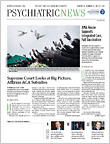We are trained quite well to use medication or psychotherapy or a combination of the two to help patients with the range of psychiatric disorders. While most patients experience a significant benefit, others either do not have a clinical response or may be treatment resistant, even after other somatic therapies are used. Thus, it is useful to have additional tools to help those patients.
An array of therapeutic modalities is available that have been well researched and proven highly effective, including holistic and complementary approaches. Our profession is accustomed to skepticism from others about even a body-mind connection so our open-mindedness can help try a related evidence-based treatment.
Two years ago, Dr. Dilip Jeste wrote in Psychiatric News about the positive neurobiological effects of meditation and the physical changes in the brain that occur when meditation is practiced. Other modalities such as breathing techniques and heart rhythm coherence training are also quite effective and easy to learn, but this article will focus on relaxation-response training and mindfulness meditation. Both techniques activate the parasympathetic nervous system, leading to many positive benefits. These include the ability to have a greater stress tolerance, improved concentration, more restful sleep, and a reduction in anxiety-related disorders.
To master these techniques and maximize their effectiveness, patients must practice them regularly, optimally 10 to 20 minutes twice a day. For relaxation response in particular, patients should choose a quiet place that is free from distractions and sit in a comfortable, upright position; eyes should remain closed.
The relaxation-response technique has demonstrated value over many years since its creation by Dr. Herbert Benson, a professor of medicine at Harvard. Even though a variety of methods can be used, patients should start by deeply relaxing their muscles beginning at their feet and breathing through their nose. While breathing out, they can say a word such as “one” or “peace” to themselves. This shifts the mind from logical, externally oriented thoughts to an internal focus. Patients should maintain this passive attitude, ignore distracting thoughts, and dismiss any concerns they may have about “success” in meditation.
With mindfulness meditation, attaining a nonjudgmental, detached, self-observing stance is the goal with a moment-to-moment awareness of whatever is being experienced. Attention should be centered on inhalation and exhalation. The body is scanned starting with the toes, and tension is released with progression up the body to the head. Sounds, physical sensations, and breathing can also serve as vehicles for mindfulness. After practicing mindfulness, patients should be able to respond to stress with more calmness and clarity, reducing anxiety and fear.
Since our time with patients is limited, I write down as “prescriptions” the names and URLs of free websites that I think may be useful to patients for whom I am recommending these techniques. Among them:
•
Mindfulness meditation: (
http://www.marc.UCLA.edu/body.cfm). The site provides short but effective guided meditations from the UCLA Mindful Awareness Research Center.
These techniques may be useful not only to our patients but also to us. Psychiatry has changed greatly since I began 36 years ago, but a regular practice of meditation has helped me adapt. Sigmund Freud thought the ideal state of mind for a psychotherapist included suspending critical judgment and focusing impartially and equally on all there is to observe. These techniques may also be helpful in reducing stress from a psychiatric practice with overbooked schedules, coding and electronic health records miscues, insurance company demands, and prescriptions needing prior authorizations or substitutions. Learning and practicing these techniques can expand on our heritage and capability. ■

